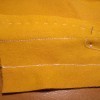Die Reihenfolge macht das Kleid / sewing order of my dresses
Geschrieben in Nähen am 09.08.2018 von Eva-Maria
Nachdem ich in drei Jahren nun vier Kleider per Hand genäht habe, die alle auf dem Schnittprinzip des Herjolfsnes-Fundes Nr. 39 (Museum No. D10581) basieren (hier mein Zuschnittschema für möglichst wenig Stoffverbrauch), hab ich eine für mich passende Nähreihenfolge festgelegt. Da ich finde, dass ich damit effizienter arbeite und zugleich das Kleid nochmal an die Figur anpassen kann, möchte ich meine Herangehensweise mit euch teilen. Nach dem Zuschnitt der Teile sieht meine weitere Vorgehensweise folgendermaßen aus.
- Ich nähe die Front - und Rückengeren zusammen & versäubere die Naht.
- Ich nähe die beiden Seitenteile zusammen und versäubere die Naht.
- Ich schließe die Schulternähte und versäubere sie.
- Mithilfe von groben Vorstichen hefte ich die zusammengenähten Seitenteile provisorisch ein und probiere das Kleid an. Da jeder Stoff sich anders verhält und auch anders fällt, passe ich nun das Kleid an die Figur an, bis es sitzt.
- Enlang der Heftlinien nähe ich nun die Seitenteile in das Kleid ein (und entferne gleichzeitig Schritt für Schritt den Heftfaden); Anschließend trimme ich die Nahtzugaben und versäubere sie.
- Nun wird es Zeit für die Mittelgeren: Ich probiere das Kleid an und markiere die Höhe, wo die Spitze der Gere eingesetzt wird; Anschließend falte ich Vorder- und Rückenteil jeweils in der Mitte und schneide einen Schlitz in der gewünschten Länge (einige mm Nahtzugabe für die Spitze reichen aus); Dann setzte ich die Geren ein (Mein Tutorial dazu gibt's hier) und versäubere die Naht.
- Nun kommt der anstrendende Teil: Die Saumversäuberung! Da ich aus Erfahrung weiß, wie mühselig die Saumnaht am Ende der Nähprojektes sein kann und wie oft man/frau daher gerne mal ohne genähten Saum das Kleid für fertig erklärt, ziehe ich diesen Schritt vor (Alles nur, um meinen inneren Schweinehund zu überlisten); Es ist damit nicht weniger zeitaufwendig, aber es macht mehr Spaß.
- Nach gefühlten 100 Metern Saumversäuberung wird es nun wieder spannend - die Ärmel stehen an. Da ich diese bisher nur als großes Rechteck zugeschnitten habe, messe ich nun das Ärmelloch aus und zeichne den Ärmelschnitt direkt auf den Stoff. Nach mehrmaligem Nachmessen und unter Zusammen nehmen all meines Mutes schneide ich anschließend die Ärmel zu.
- Als nächstes werden die Ärmelgeren eingesetzt und die Naht auf der Armrückseite - je nach Gestaltung des Ärmels - bis zur Knopfleiste bzw. zum Handgelenk geschlossen und alle Nähte versäubert.
- Dann werden die Ärmel eingeheftet, das Kleid anprobiert und der korrekte Sitz der hinteren Ärmelnaht überprüft. Wenn alles passt, nähe ich die Ärmel final ein (hier versäubere ich die Naht eigentlich nie)
- Falls zutreffend, werden nun die Knopfloch- und Knopfleisten versäubert und die Länge der Ärmel angepasst.
- Danach lege ich den Ausschnitt des Kleides fest und versäubere ihn mit einem Seiden- oder Leinenstreifen. Eine Reihe kleiner Vorstiche hält den Ausschnitt in Form.
- Knöpfe annähen: Falls Stoffknöpfe verwendet werden, stelle ich diese in diesem Schritt her (Tutorial) und nähe sie an; Metallknöpfe werden einfach nur angenäht;
- Knopflöcher versäubern: mit farblich passendem Woll- oder Seidengarn fasse ich die Knopflöcher mittels Knopflochstich ein.
- Anziehen und freuen! Endlich ist das Kleid fertig und kann voll Stolz auf der nächsten Veranstaltung vorgeführt werden!
After sewing four dresses - all based on Herjolfsnes finding No. 39 (Museum No. D10581) - in three years, I finally established my own kind of sewing order. As it works fine for me and allows me to sew the dress and adapt the fit at the same time, I thought I would share my approach with you. After cutting out the pieces (see here my post on cutting a Herjolfsnes dress economically), I sew them together following this scheme.
- First, I sew the pieces of the front and back gores together and neaten the seam allowance.
- Then I sew the side pieces together and trim them.
- Next, I close the shoulder seams and trim them.
- With the help of crude running stitches, I sew the side pieces in provisionally and try the dress on. Now is the time to adjust the fit of the dress until it suits my vision.
- Afterwards, I sew the pieces together with the "real" thread, using the running stitches as guidelines and taking them out as I go. Then I finish all seams off neatly.
- Now it's time to insert the front and back gores. For this, I try the dress on one more time and mark the place where the point of the gore will be. Then I fold the back and front pieces of the dress in half, cut the slits and sew in the gores (here's my tutorial on how to insert gores). Again, I neaten all seams before moving on to the next step.
- Next comes an exhausting piece of work - finishing the hemline. I usually prepone this step as I know from experience that I am too lazy to do it in the end. I'd rather declare the dress finished without a neat hemline and to prevent myself from doing that, I chose to place this step in the middle of my sewing order. It doesn't make the whole thing less tedious, but I am more motivated to tackle it.
- After what feels like 100 meters of hemming, it's time to cut the sleeves which have so far only been huge rectangles. I measure the armholes, draw the sleeve pattern directly on the fabric and - after checking time and again if I have the right dimensions - finally cut the sleeves out.
- Then, the gores on top of the sleeves are set in and the backside seam is closed and neatened. Depending on the type of sleeve the seam is sewn shut until the wrist or only to the ellbow to allow for a buttoned fastening.
- Once again I provisionally sew something in - in this case I place the sleeves and check the correct fit and placement of the backside seams. If everything is alright, I replace the running stitches with more durable sewing (again taking them out as I go). This time, the seam allowance goes unfinished.
- If I use buttoned sleeves, now's the time to neaten the button border and adjust the sleeve length.
- Next, I decide on the neckline of the dress, adjust it and trim it with a silk or linen bias tape. A tiny row of running stitches helps it to stay in shape.
- Buttons are next! If I use cloth buttons, step 13 is when I make them and sew them on (tutorial). In case of metal buttons they are simply sewn on.
- Buttonholes come after - I usally finish them with color-coordinated silk or wool thread, using buttonhole stitch.
- The dress is finished! Put it on and proudly wear it to the next historical event!





